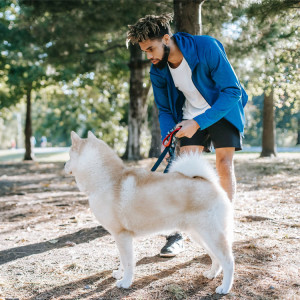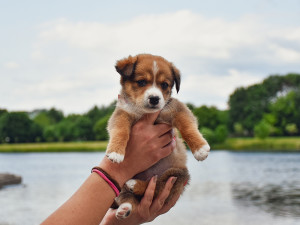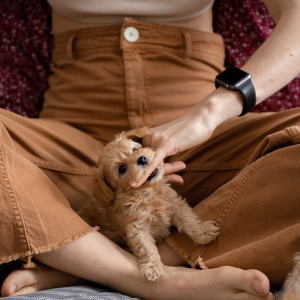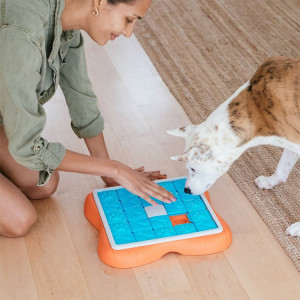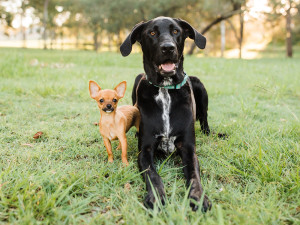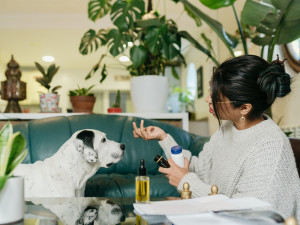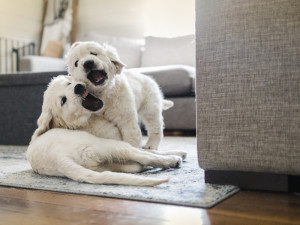How to Teach a Dog to Fetch
For some dogs, it’s not as simple as just throwing a ball
The game of fetchopens in a new tab wins the prize as the ultimate good-for-us, good-for-them activity. It gives dogs exercise without us having to work up a sweat, and it’s a great way to teach dogs the crucial skill of dropping an object on cue. Since it’s fun and interactive, it enhances the relationship between us and our pups.
Some dogs are naturally good at fetch (and some will even play it by themselves). All you have to do is find a likely object (a ball, a stick, a pine cone), throw it and enjoy the fun of a good game with your dog. If you have one of these dogs, you can give them lots of exercise and they will, quite literally, consider you the best game in town. For the rest of us, there are ways to teach a dog to fetch so that you can both enjoy playing it. Many dogs who aren’t naturals at the game love to fetch once someone has taught them how to play.
littleKin™ is Kinship’s home just for puppy and kitten parents. Bop over to check out expert advice, new pet tools, and special deals—all curated for your newest family member.
opens in a new tabStep by step: how to teach your dog to fetch
To make it as likely as possible for your dog to take an interest in the game of fetch, begin teaching them inside the house. I know, I know, playing fetch in the house seems inadvisable, but it’s only temporary. Eventually, you’ll be playing outside – but by starting indoors where there are fewer distractions, it’s easier for your dog to focus. (For the sake of simplicity, I’m going to use the word ‘ball’, but fetch can be played with any toy your dog finds appealing.)
1. Play with the ball yourself for a few moments
Bounce it a couple of times, toss it in the air and catch it, or wave it around. It’s often the movement rather than the toy itself that dogs find attractive, so get that ball moving.
2. Now that they’re interested, give the ball a gentle toss
Toss no more than five feet away from you and your dog. If your dog heads in the direction of the ball and picks it up, clap gently and head in the other direction. Most dogs love a chase game, and your movement is likely to entice them to follow you. Resist the urge to call them to come or to say their name, which will make many dogs drop the ball and trot to the person calling them. If they come part way to you and then drop the ball, keep clapping and moving away from them. Consider it an unbreakable rule that they move towards you and you do not move towards them.
3. If they grab the ball and run away, start running yourself
Always run in the opposite direction. Dogs can rarely resist a chase game, and it’s up to you to be the chase-ee rather than the chaser. This isn’t easy, but making a conscious effort not to give in and chase your dog will pay off in the long run.
4. If your dog brings the ball back and drops it anywhere near you, pick it up and throw it instantly
Most of us tend to pick up the ball and hold it while we praise our dog or stroke her, but this isn’t the time for that. We think we’re playing fetch, but our dogs think we’re hoarding the ball. They want the ball back, and they want it now. Since we’re trying to make sure they love the game of fetch, we need to make it as fun as possible for them, and that means letting them have the ball, not holding on to it.
So, toss the ball the instant your dog drops it. This sounds simple, but over the years, I’ve found it to be the aspect of fetch that many people struggle with the most. Think of throwing the ball the second you get your hands on it as a challenge you give yourself. You win if you toss it right away; you lose if you hold onto it.
Fetch challenges and how to fix them
If you are having trouble teaching your dog to fetch, here are a few fixes for common fetch problems.
If your dog won’t bring the ball back
Not all dogs are interested in the retrieving part of fetch. They like the part where they chase the ball, but picking it up and carrying it anywhere is not nearly as appealing. One way to encourage a dog to bring something back to you is to choose the toy that your dog finds most interesting. That’s often a ball, but it could also be a rope, a stuffed animal or a Frisbee.
Ideally, choose a toy that you and your dog can play with interactively. So, if your dog likes to tug, play with their favourite tug toy, then toss it a foot or two away. If they bring it back, resume the game of tug for a bit before tossing it again. Once your dog is really good at bringing the tug toy back to you, you won’t need to play tug after every retrieve, but doing so occasionally is a great way to maintain their interest in fetching. If your dog likes you to squeak a fleece toy as you play with them, make it squeak, then toss it and squeak it again if they pick it up and bring it to you.
Some dogs prefer to pick up food, so if you can make the toy smell like food, they may pick it up. Soak a ball in some chicken soup or rub a little bit of peanut butteropens in a new tab on it and see if that piques their interest. If they bring it to you, put a bit more food on it and toss it a few feet away. They may think of this game as an “active dinner”, but it’s a form of fetch that teaches them to follow a toy, pick it up and bring it back to you. I have known quite a few dogs who began to fetch this way and learned to like more standard fetch games that didn’t involve food.
If your dog won’t drop the ball
Many dogs are so excited about the ball that they don’t want to give it up. One way to convince these dogs to let go of the ball is to put a treatopens in a new tab right under their nose, which will prompt most dogs to release the ball to eat the treat. If you do this, throw the ball again immediately so that the focus returns to the game. Having a dog who drops the ball in response to a treat may not be what you have in mind, but it’s a way to teach them to drop the ball in response to a cue.
Once your dog reliably drops the ball when a treat is put under their nose, add in a cue. Say ‘drop it’, then put the treat under their nose, giving it to them once they release the ball. With repetition, dogs learn to drop the ball when you give the cue, and you can gradually decrease the use of treats. Throwing the ball again is also a reinforcement for dropping the ball, and it’s often the case that continuing the game is worth more to dogs than treats.
However, some dogs are so distracted by treats that it’s hard to resume a fetch game if treats are around. This problem can be resolved by using multiple balls. As soon as your dog comes near you while holding the ball, throw another ball; it may help to bounce it or toss it in the air a few times first. Most dogs will chase the moving ball and let go of the one in their mouth to pick up the new one.
When you use multiple balls, your dog may drop them all over the place, especially at first, so you might be doing some fetching yourself. But once dropping a ball to go after another one becomes a habit for them, they’re more likely to drop it near you, so the extra exercise should only be temporary.
If your dog loses interest after a few throws
At first, many dogs will quickly lose interest in the game. If you want your dog to play fetch longer, there are ways to make that happen. For example, dogs will often give it more time when playing inside, where there are fewer distractions (especially smells). Even if you eventually want to play outside, increasing the length of indoor sessions will help you achieve that goal.
Another strategy is to stop fetch sessions before they give up on them. That leaves them wanting more, which will make them more likely to fetch longer in the future. Pay attention to patterns: if they regularly fetch four times before losing interest, only throw the ball three times during your next few games. Then, gradually increase the number of throws – four or five, then six or seven and so on.
Making the game more exciting is another great way to expand the length of time you can keep your dog interested in the game. There are many ways to do that. Here are a few:
Run away when they’re bringing the ball back to you, which makes many dogs more enthusiastic about playing.
Try to play during the part of the day when they’re the peppiest and most energetic. For many dogs, that means mid-morning and late afternoon, but each dog is different, so put on your scientific observer’s hat and figure out what’s the best time for your dog.
The toy you use can influence how long they play. If you use a squeaky ball and squeak it a few times before each throw, they may stay interested longer.
Most dogs find the next throw a great reinforcement for fetching, but if your dog prefers tug or chase, reinforce each retrieve with a brief session to keep the game exciting until they’re happy playing for a longer time.
If your dog prefers playing keep-away more than playing fetch
In this situation, the most important piece of advice is not to give in and chase them. Being chased is endlessly fun for dogs, but if you start chasing her, you will be doing so endlessly. Stick to the rules of fetch: your dog moves towards you; you do not move towards your dog.
Play fetch with multiple toys and throw them in unpredictable directions, so they don’t know which way to run until you throw. If they do not chase the object and continue to run away from you in random directions, stop the game and try again later. Stopping the game is a way to teach them that if they run away from you in an attempt to initiate a game of chase, playtime ends.
If your dog never wants to stop playing
Some dogs are too enthusiastic about fetch, and don’t take it well when the game ends. One of the best ways to handle this is to teach your dog that when you say “one more”, you will only throw the ball a final time. Communicating the intent to end the game helps many dogs cope because they are not caught off guard.
With some dogs, you can let them keep the ball after the last toss, but if your dog keeps putting the ball at your feet and waiting for a throw you don’t intend to make, it’s best to pick it up and put it away when the game is over. Another way to ease end-of-the-game pain is to follow it with something else your dog likes, such as a training session, a walk or a massageopens in a new tab.
If your dog learns that the end of fetch is not the end of happy times with you, it becomes easier for them to accept that the ball will not be thrown again right now. Adding an activity after fetch may not be easy to fit into your schedule, but if you can commit the time, it’s a great option.
If your dog gets overly excited during fetch
Dogs who struggle with emotional control can sometimes get nippy while playing fetch. The out-of-control behaviour is generally all about arousal, and that should be addressed in order for fetch to be fun for both of you. Dogs need to develop and practise self-control to be able to play appropriately, and it’s easier for them to do that if we work on lowering the arousalopens in a new tab level.
It’s normal to contribute to the fun of fetch by acting upbeat and goofy. That may mean saying, “Here you go! Good dog!” and then throwing the ball, clapping, running away and offering enthusiastic praise. But if your dog gets too revved up to control their body and their mouth, do none of that. Instead, calmly toss the toy a short distance away, then say “Goooood” in soothing tones when they return it to you.
You can gradually work up to playing fetch with greater amounts of energy and excitement and joy, but start in low-arousal mode. If a particular type of toy excites your dog, avoid it and use ones without such a pepping-up effect. Commonly, that means starting with a stuffed toy rather than a ball, although for some dogs, a ball is fine but a Frisbee makes them get very worked up.
To control arousal, pause while playing. Every two, three or four throws, ask them to do something: a sit still, a down or a stay are all good candidates. Doing almost any behaviour or trick they know how to do on cue can have a calming effect. (The exception is ‘spin’, which I’ve found revs up so many dogs that I don’t ask for it in this context.)
Also, I always like to do at least two throws. It’s not that I would never do just one if things seemed to be getting out of hand, but as a rule, I try to do at least two to get that turnover so that the fun stays in the game. If the pauses aren’t enough to control the arousal and they are just too mouthy, stop the game and redirect them to another activity – a walk, a bone to chew or a training session.
If your dog is not interested at all in fetch
Some dogs show no interest in fetch and don’t respond to the most common ways to get the game going. If your dog is like this, don’t despair. Many dogs start out with little interest in or understanding of retrieving, but come to enjoy it through the use of a treat-stuffed toy.
Make the food relatively difficult to extract, toss the toy just a few feet, then take the toy away from them, remove some treats and give the treats to them. Once they learn that the fastest way to get the treats is to bring the toy to you, they are technically retrieving. The next step is to take the toy from them when they head your way but give them treats from your pocket rather than from the toy. Eventually, you won’t even need to stuff the toy. You’ll be able to toss the toy and then offer treats when your dog brings it back to you.
Another option is to teach a dog to fetch as a trick by using shaping, which is reinforcing successive approximations of the behaviour that you eventually want. With fetch, that means you’ll begin by offering your dog treats for showing any interest in the toy. For some dogs, “interest” may be poking at it with their nose, but for others, it may be walking toward the toy or even just looking at it. Once the dog learns that this initial behaviour earns treats, you require the dog to do more to earn them.
The series of steps may include touching the ball or toy, nudging it, taking it in their mouth, picking it up, walking a step with it, taking it in your general direction, taking it part of the way to you, bringing it all the way to you and dropping it. Some dogs who learn to play fetch this way grow to love it and want to play the game. A caveat: while some dogs will happily do it as a trick, they won’t necessarily develop a great love of fetching for fetching’s sake.
Teaching your dog fetch requires patience
To achieve the goal of happy games of fetch with your dog, be open-minded about how to teach it and choose the methods that best suit your particular dog. Help them succeed by moving away from them to encourage them to come to you, reinforce anything that approximates fetch as they begin to learn to play and resist their attempts to teach you to play “chase the dog around the garden”. Have fun, and play ball!


